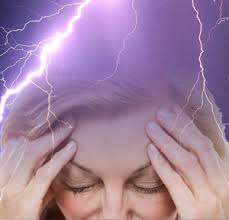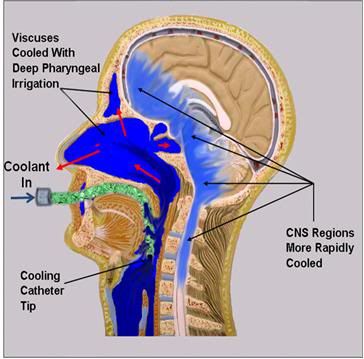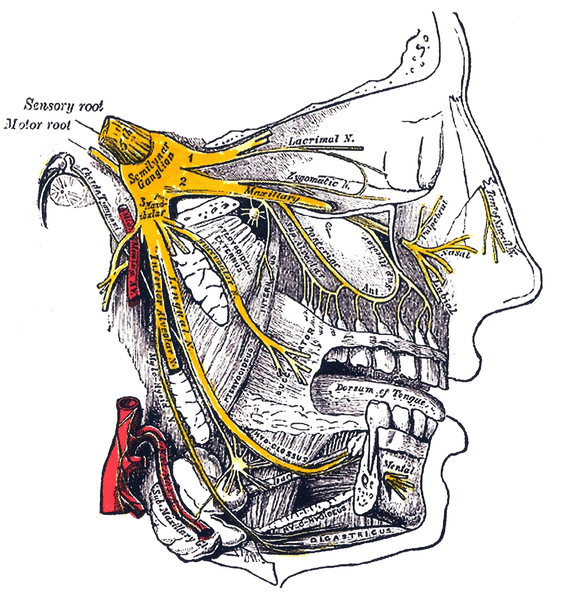DEFINITION
"pain in the cranial region that may occur as an isolated and benign symptom or as a manifestation of a wide variety of conditions."

EPIDEMIOLOGY
Forty-five million Americans seek medical attention for head pain yearly and most of them have migraine. Migraine causes the loss of approximately 150 million work days per year at an estimated lost labor cost of $13 billion.
Migraines show a strong pattern of inheritance likely representing a complex interaction of multifactorial genetics and variable penetrance with environmental influences. Migraineurs are physiologically and perhaps psychologically hyperresponsive to a variety of internal and external stimuli. It is known that a plethora of various trigger factors may set off an attack in susceptible sufferers. Examples of such triggers include foods such as wine, chocolate, and caffeine; stress or the sudden lack of it; changes in sleep patterns; and hormonal fluctuations at various times in women's life. Some of those with headache also report that weather has a significant and consistent impact on their headache. They also believe that they know which weather factors are most likely to trigger their migraine attacks.
There is no difference in the prevalence as regard sex, age, and the belief that weather was a trigger.
(Triggers of migraine and tension-type headache, 2010)
(Food as trigger and aggravating factor of migraine,2012)
(Headache and sleep disorders: review and clinical implications for headache management,2006)
(Migraine headache in perimenopausal and menopausal women,2009)
(Weather sensitivity in migraineurs,2010)
(Does low atmospheric pressure independently trigger migraine,2011?)
PATHOGENESIS
There are several studies investigating the relationship between weather and headache, with contradictory findings.
Early studies examining this possibility have yielded inconsistent results. The variability in prior findings may be due, at least in part, to the lack of systemic comparisons of a wide range of climatic parameters in relation to headache, as well as the lack of adequate analytical methods to investigate weather data, which are often highly dynamic on multiple time scales.
Recent reports have indicated that several weather parameters may be associated with headache, including ambient temperature, barometric pressure, wind speed, relative humidity and precipitation
Since headache is a typically multifactorial disease, it’s not possible to find a unique and common cause to explain every episode, however the progressive individuation of triggering factors may improve the predictability and the assignement to a therapeuric protocol. In this case we’ll focus on factors regarding the weather, that by interacting with others favor the onset of headache episodes.
The relationship between weather and headaches is, however, still poorly understood.
several mechanisms and factors have been proposed and underwent a first experimental evaluation
(Temporal associations between weather and headache: analysis by empirical mode decomposition,2011)
“Atmospherics” or “Sferics”
Some authors hypothesize that sferics, electromagnetic impulses of very short duration and low intensity generated by electric discharges, could be relevant migraine-triggering factors

Sferics are electromagnetic impulses of very short duration (500 µs) and low intensity (below some 100 nT). They are of very low frequency (VLF range, 1–100 kHz) and exhibit an frequency maximum around 10 kHz. It is only partially clear what meteorological situations are causal for sferics. They are generated by electric discharges, mainly during thunderstorms (lightning) and similar meteorological situations in the atmosphere.

Sferics show an extremely long range and, due to ionospheric reflection, may travel thousands of kilometres around the earth. For this reason local numbers of sferics pulses may be substantial even in the absence of regional thunderstorm conditions. The magnetic component of sferics penetrates into buildings and into the human body. For this reason interaction with human cells or membranes does occur though the involved field energy is exceedingly small. At any location sferics pulses arrive from all directions, depending on where most prominent thunderstorm conditions develop. Many different sources contribute to the total local intensity, therefore one observes large daily and seasonal variations.
(Electronic momentary assessment of weather changes as a trigger of headaches in children,2009)
(headache and sferics,2001)
evolutionary hypothesis
The basic idea behind this could be that of an evolutionary relic. For our ancestors it could have been of immense evolutionary advantage to be able to tell in advance when bad weather or thunderstorms were approaching. Thus, the meteorological sensitivity of headache patients might be a fossilized sensitivity of those patients to atmospheric electric changes, which once was useful, but now is of only marginal importance. It is important to note that a possible influence of the non-ionizing radiation must be strictly non-thermal because the transmitted pulse-energy is many orders of magnitude too low to induce thermal effects.
mechanism of action
It is the electromagnetic change which goes together with weather changes that affect headache patients. Two most recent experimental studies could show some support for this hypothesis . In the first study artificial sferics simulating medium-distance thunderstorms were produced and the influence of the these sferics was tested on the alpha band of the EEG in the parietal and occipital area of the brain of volunteers. The alpha band showed changes in 10 of 30 locations, and the beta band in four of 24 comparisons. The effects are rather weak but they give a hint that sferics may influence the EEG.
The electrical charges (positive ionisation and sferics) engendered by every incoming weather front produce a release of serotonin, this may be the mechanism which induces the change of the EEG.
(Electrocortical responses of headache patients to the simulation of 10 kHz sferics,1999)
(Sferics provoke changes in EEG power,2001)
(Effects of low-frequency magnetic fields on electrocortical activity in humans: a sferics simulation study,1999)
(Migraine and headache due to weather and allied causes and its specific treatment,1980)
If we look at the amount of electromagnetic radiation brought into the environment by various electric devices, such as mobile phones, computers or other everyday applications,* it might be of clinical importance that some headache patients could potentially be sensitive to these electromagnetic radiations.*
Cold:
from epidemiological studies it is possible to identify a correlation between athmospheric temperature (or also oropharingeal temperature in the icecream headache and headeache, cold acts in several ways
mechanisms of action
first
Cold temperature vasoconstriction with onset of ischaemic pain
Using transcranial Doppler ultrasonography, we measured the middle cerebralarterial flow velocities in two subjects who developed a headache, and in one who did not, when they were eating ice cream. When the headache developed the mean flow velocities decreased from 72 to58 cm/s and from 51 to 33 cm/s. There was no change in mean flow velocity in the subject who did not get a headache. Although the brain temperature was not directly measured, these observations suggest that cerebral vasoconstriction causing a decrease in flow may be important in the development of an ice cream headache. They do not shed light on whether the change in cerebral blood flow is mediated intracranially (due to an overreaction of a vasogenic reflex responding to a small drop in the temperature of the carotid blood) or is due to a reflex response triggered by the sensation of cold in the palate or oropharynx.
(Ice cream evoked headaches (ICE-H) study: randomised trial of accelerated versus cautious ice cream eating regimen,2002)
(ice cream headache,1984)
(Visual aura in ice cream headache,2004)
(Ice cream headache. Cerebral vasoconstriction causing decrease in arterial flow may have role,1997)
second
For direct vasoconstriction of the cerebral vessels due to transnasal cooling
The brain is a sensitive organ, to finction correctly a precise internal homoeostasis is necessary, among the factors in dinamic equilibrium on is the temperature of the organ itself. A mechanism to grant a correct convective cooling of the brain is transnasal cooling, the brain blood flow may exchance warmth in the paranasal sinuses. This mechanisms, evulutionally conserved, may sometimes function in an uncorrect way and cause overheating problems (e.g. because of the formation of a mucus clog that hinders the air flow between the paranasal sinuses and the rhinopharynx)

(Transnasal cooling: a Pandora's box of transnasal patho-physiology,2011)
third
Pain from hyperstimulation of the trigeminus associated to a lack of the central system for the control of pain.
Idiopathic stabbing headache (ISH) and ice cream headache occur due to paroxysmal firing of trigeminal pathways and a defect in pain control mechanisms. Any defect in pain control mechanisms appears to be localized to the affected areas. Therefore, we compared ISH and experimentally induced ice cream headache localizations in the same group of migraine sufferers to investigate similarities and differences between these headaches. The percentage of ice cream headache localizations restricted to 'in front of the vertex/on the vertex' was 94%, while it was 45% for ISH. The percentage of ice cream headache occurrence behind the vertex was 6% and 55% for ISH. Due to the widespread distribution of ISH in the head, there might be irritation of various branches of the trigeminal nerve, while the restricted localizations of ice cream headache suggest irritation of a certain branch or branches of the trigeminal nerve, e.g. in the oropharynx. Either widespread or restricted irritation of trigeminal pathways causes either ISH or ice cream headache, in which intermittent deficits in central pain control mechanisms seem to be playing the key role.


(Idiopathic stabbing headache and experimental ice cream headache (short-lived headaches),2004)
(Central mechanisms of peripheral nerve stimulation in headache disorders)
conclusion
headache is a biological disorder with a well-defined set of trigger factors. Despite the advances in the study of headache, there has been limited progress in the study of trigger factors. Identifying trigger factors can lead to preventive strategies such as trigger avoidance or preparing to take acute care medications in advance. Conversely, misidentification of trigger factors can lead to unnecessary restrictions in diet and lifestyle
The studies demonstrates that there is a relationship between weather and headache . It provides a piece of information to the growing wealth of data on headache, and complicates the puzzle of headache triggers. But the patients might be susceptible to weather in their own ways.
If patients and their physicians pay close attention to personal patterns in weather sensitivity, it may be possible to prevent the onset of headache in many situations, and in others prepare to be armed to initiate treatment when headache begins.
Enrico Badellino
Sara Gianola